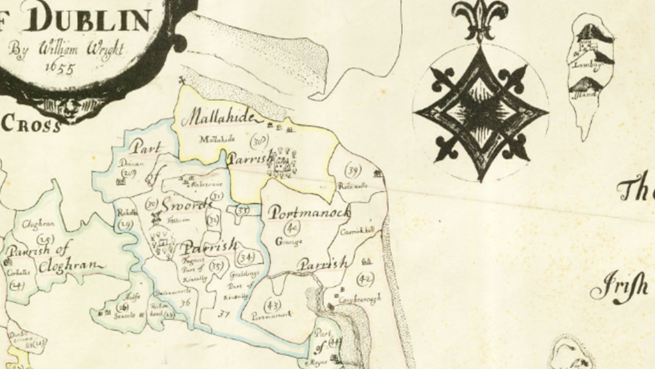The Many Names of Malahide

Fig 1: Malahide in a Down Survey Map[1]
For this instalment of Fingal Folktales, I am exploring the potential meanings of the placename Malahide. Mullach Íde is given as the official Irish translation of Malahide on the placenames database of Ireland[2]. Mullach which means summit or high place appears in several other placenames around Ireland including the well-known Mullaghmore in county Sligo[3]. According to local tradition ‘’It is said that Malahide or "Mullach Íde" got its name from a man named Íde who lived on the hill in Malahide and the place is therefore called Mullach Íde or Hill of Íde’’[4]. It does not appear that any folktales, myths, or legends about a man called Ide have survived if they ever existed at all. However, within the medieval literature Íde was recorded as a female saint who founded a convent called Cill Íde or Kileedy in Limerick[5]. Most of the surviving folklore about Íde comes from Limerick and there are no surviving Fingallian stories about this saint. However, as Íde is sometimes anglicised as Ita the proximity of St. Ita’s hospital in Portrane suggests Ita or Íde may have been a local saint celebrated in the Malahide area[6].
Alternate Meanings
While Mullach Íde is given as the official Irish name for Malahide several Irish language variants of the name also exist. A local tradition suggests that Mullach-Ide meaning ‘’The Sandhills of the Hydes’’ was named after the Norman Hyde family who lived across the estuary in Donabate[7]. The placenames database of Ireland has preserved a multitude of alternative translations of Malahide in their archival collections. These include Maol’ a hÍde, Béal Átha Thíd, Mullachydebeg, Malehide, Molaghide and Mullagh – hÍde meaning ‘The head land of the extremity of the tide’[8].
Both local stories and the placenames database have preserved Inbhear Domhainn as yet another potential name for Malahide. According to local tradition, Inbhear Domhainn is named for the Fir Domhnainn a tribe of the Fir Bolg who landed there in prehistory[10]. Scholarship suggests the name Fir Domhnainn is cognate with Dumnonii a name for a Celtic people who lived in Britain and Western Europe[11]. The name Inbher Domhainn and its association with the Fir Domhainn could then represent a memory of Celtic connections in the Malahide estuary. However, entries in the placenames database also suggest Domnann as a topographical name marking the place where the Ward and Meadow rivers meet[12]. Inbhear Domnainn was also called Maeil Domnainn and Inbher Meilg (Thaoide) in reference to the dangerous whirling currents of the estuary. Indeed, the estuary area is well signposted today to warn against swimming there due to dangerous currents.
We cannot say for sure where the name Malahide originates from, but the preservation of these variants allows a multifaceted understanding of this place. All at once the name Malahide encapsulates Celtic connections, a local saint, Norman nobility, a high place, and a dangerous whirling river mouth.
Want to Delve Deeper?
If you want to find out more about your local place names visit Loganim.ie which is the digital gateway to the placenames database of Ireland. If you are interested in visualising how place names and areas develop over time visit Geohive where you can view and layer both modern and historic maps. Excellent research on Malahide is available on both the Malahide historical society and Old Yellow Walls websites.
- Aoife Walshe.
Bibliography
Flanagan, Deirdre & Laurence (2002), Irish Place Names, Dublin.
O hOgain, Daithi, (1990) Myth, Legend & Romance: An Encyclopaedia of the Irish Folk Tradition, England.
Old Yellow Walls, ‘’The Old Sea Road’’, accessed through https://oldyellowwalls.org/ on 17/04/2021.
Old Yellow Walls, ‘’Inbher Domnainn’’, accessed through https://oldyellowwalls.org/ on 17/04/2021.
The Down Survey of Ireland, Trinity College Dublin, accessed through http://downsurvey.tcd.ie/down-survey-maps.php#c=Dublin on 20/04/2021.
The Lawrence Photograph Collection, National Library of Ireland, accessed through http://catalogue.nli.ie on 20/04/2021.
The Placenames Database of Ireland, accessed through https://www.logainm.ie/ga/17019 on 18/04/2021.
The School’s Manuscript Collection, accessed through https://www.duchas.ie/en on 18/04/2021.
FOOTNOTES
[1] (accessed through http://downsurvey.tcd.ie/down-survey-maps.php#bm=Coolock&c=Dublin)
[2] (Placenames Database accessed through https://www.logainm.ie/en/17019?s=malahide)
[3] (Flanagan 2002: 124)
[4] (The Schools’ Collection, Vol 0791: 122)
[5] (O hOgain 1990: 259)
[6] (The Schools’ Collection, Vol. 0493: 259)
[7] (Old Yellow Walls, ‘The Old Sea Road’ accessed through https://oldyellowwalls.org)
[8] (Archival Records of the Placenames Database, accessed through https://www.logainm.ie/en/17019?s=malahide)
[9] (accessed through http://catalogue.nli.ie/Record/vtls000325651 on 20/04/2021)
[10] (Archer 1975: 8; Old Yellow Walls, ‘Inbher Domnainn’ accessed through https://oldyellowwalls.org)
[11] (O hOgain 1990: 226)
[12] (Archival Records of Placenames Database accessed through https://www.logainm.ie/en/17019?s=malahide)
![Fig 2: Malahide ca. 1865-1914[9]](/sites/default/files/styles/user_defined/public/2021-04/malahide-estuary.png?h=b4074041&itok=ywc3klpV)